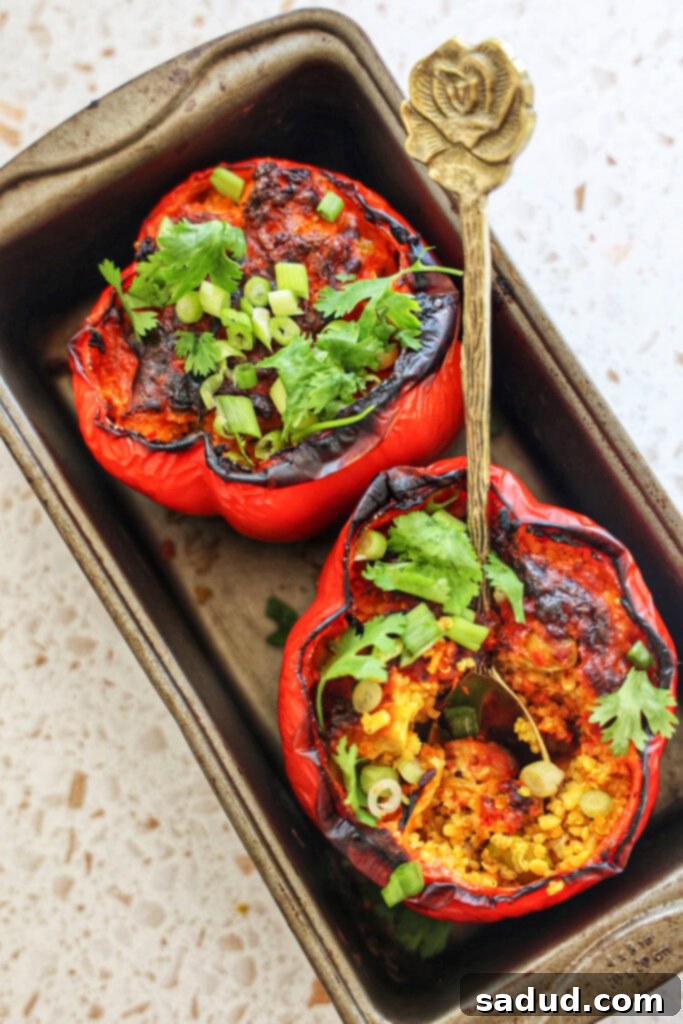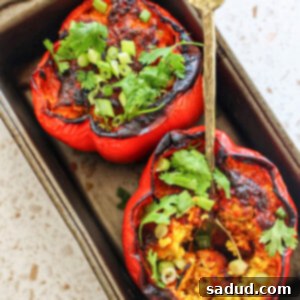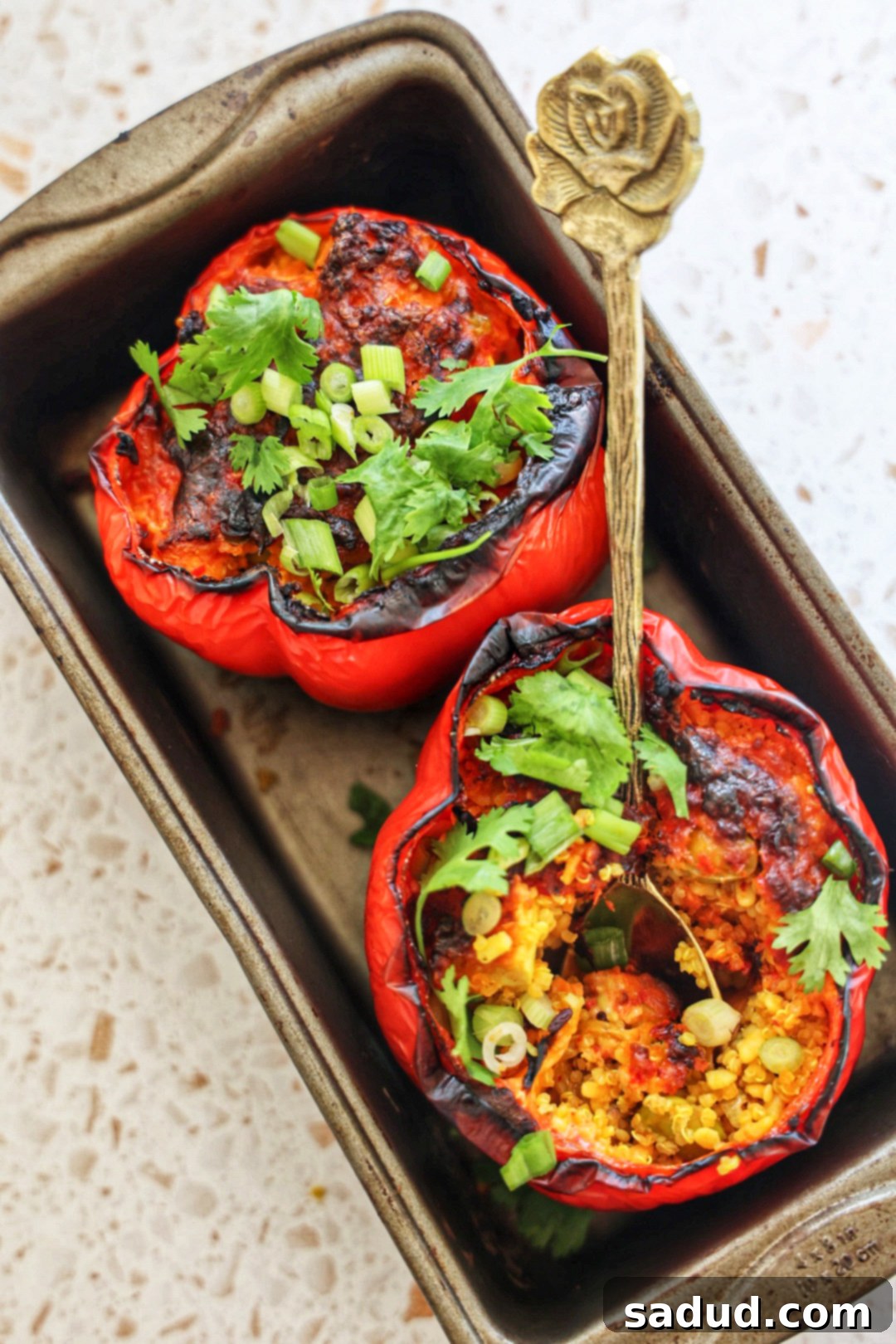Thai-Inspired Quinoa Stuffed Peppers: A Healthy & Flavorful Meal Prep Recipe
Get ready to elevate your dinner game with these incredibly delicious and vibrant Quinoa Stuffed Peppers with a Thai flare! This recipe takes a beloved classic and infuses it with the aromatic, savory, and slightly spicy flavors of Thai cuisine, making for an unforgettable meal. Each bell pepper half is generously loaded with a satisfying mixture of protein-packed quinoa and edamame, fresh, crisp vegetables, all bound together with an irresistible, creamy Thai peanut sauce. Whether you’re planning your weekly meals or need a quick yet wholesome dinner, these stuffed peppers are a fantastic choice, delivering a powerhouse of healthy protein, beneficial fats, and essential fiber in every bite.

Why You’ll Fall in Love with These Quinoa Stuffed Peppers
While the culinary world offers a myriad of stuffed pepper recipes, this Thai-inspired version truly stands out. It’s a delightful departure from the traditional, offering a unique flavor profile that’s both comforting and exciting. My personal love for Thai peanut sauce inspired this creation, and I knew it would be the perfect complement to the fresh ingredients. Imagine all your favorite Thai salad mix-ins, from crunchy cabbage to nutrient-dense edamame, perfectly tossed in what I truly believe is the best peanut sauce ever!
Beyond their incredible taste, these stuffed peppers are designed for convenience. You can significantly streamline your cooking process by using pre-cooked quinoa – a fantastic time-saver often found in grocery stores. Alternatively, preparing a larger batch of quinoa ahead of time ensures you always have this versatile grain ready for various meals throughout the week. If you prefer to cook everything fresh, quinoa can be simmering on the stovetop while you efficiently chop and prepare the remaining filling ingredients.
These aren’t just tasty; they make a genuinely healthy dinner! Each serving is brimming with an abundance of wholesome vegetables, healthy fats from the peanut sauce, and a significant boost of plant-based protein. This makes them a triple threat for nutrition, keeping you feeling full, energized, and satisfied without compromising on flavor.
Finally, their versatility is unmatched. Don’t have a specific vegetable on hand? No problem! This recipe is incredibly forgiving and encourages you to utilize whatever fresh produce you have in your refrigerator. It’s a wonderful way to minimize food waste and experiment with different flavor combinations based on seasonal availability.
Making These Quinoa Stuffed Peppers Fit Your Dietary Needs
One of the best aspects of this recipe is its adaptability. With a few simple tweaks, these Thai-inspired quinoa stuffed peppers can easily cater to a variety of dietary preferences and restrictions, ensuring everyone can enjoy this flavorful dish.
- Soy-Free: If you’re avoiding soy, simply omit the edamame. You can easily substitute it with other protein-rich legumes like green lentils, black beans, or chickpeas for a similar texture and nutritional punch. Ensure your liquid aminos are coconut aminos or another soy-free alternative.
- Low-Carb: For a low-carb alternative, swap out the quinoa for cooked cauliflower rice. The texture will be slightly different, but it will still absorb the delicious Thai flavors beautifully and provide a nutrient-dense, lower-carb option.
- Peanut-Free: A peanut allergy doesn’t mean you have to miss out on the creamy sauce! Simply use almond butter, cashew butter, or for a completely nut-free option, sunflower seed butter (also known as “SunButter”) in place of peanut butter in the sauce. All these alternatives provide a rich, creamy base that holds the Thai flavors wonderfully.
- Gluten-Free: This recipe is naturally gluten-free, provided your liquid aminos (or soy sauce alternative) are gluten-free, such as tamari or coconut aminos. Quinoa is also naturally gluten-free.
Can I Add Extra Protein to My Stuffed Peppers?
Absolutely! While this recipe already provides a robust amount of plant-based protein from the quinoa, edamame, and even hemp seeds (if you choose to add them), you can certainly boost the protein content further. This makes the dish even heartier and more satisfying, perfect for active individuals or those looking to increase their protein intake.
- For Meat Eaters: Feel free to mix in cooked ground beef, chicken, or turkey with the quinoa filling. Simply brown your preferred meat in a skillet before adding it to the vegetable and quinoa mixture. Season it lightly to complement the Thai flavors.
- For Vegan/Vegetarian Options: Crumbled and cooked tempeh or extra-firm tofu are fantastic vegan additions. You can press the tofu to remove excess water, then crumble or dice it and sauté until lightly browned before incorporating it into the filling. This adds an extra layer of texture and protein.
Even without these additions, remember that quinoa is a complete protein, and edamame is a great source of plant-based protein, making this recipe a naturally protein-rich meal on its own.
Ingredients & Thoughtful Substitutions
Let’s dive into the core components of these delightful stuffed peppers and explore how you can customize them based on your pantry and preferences:
- Bell Peppers: Any color bell pepper will work wonderfully – red, yellow, orange, or green. Red, yellow, and orange peppers tend to be sweeter, while green peppers offer a slightly more bitter, earthy flavor. The key is to choose large, firm peppers that will comfortably hold a generous amount of stuffing. For easier handling, opt for peppers with flat bottoms.
- Quinoa: This ancient grain is the heart of our filling, offering a complete protein profile and a satisfying texture. As mentioned, using store-bought prepared quinoa or cooking a batch beforehand is a great time-saver. If you’re cooking it from scratch, follow package instructions (typically 1 part quinoa to 2 parts water, simmered for 15 minutes until liquid is absorbed). Alternatively, brown rice, farro, couscous, or even wild rice can be used. For a low-carb version, cauliflower rice is an excellent substitute, just ensure it’s cooked until tender before mixing.
- Edamame: I specifically chose edamame for its vibrant color, slightly sweet flavor, and significant protein boost, especially in Thai-inspired dishes. If edamame isn’t your preference or available, feel free to substitute with shelled green peas, chickpeas, or for a different texture, hemp hearts (though they won’t offer the same bulk).
- Veggies: My preferred mix includes fresh spinach, shredded carrots, and shredded cabbage for a classic Thai salad crunch and nutrients. However, this is where you can truly get creative! Consider adding finely diced mushrooms, zucchini, bell pepper scraps (from the tops), broccoli florets, or even chopped kale. Buying pre-shredded coleslaw mix can be a fantastic shortcut to reduce chopping time.
- Spice & Herbs (Curry Paste): Red curry paste is our secret weapon for infusing deep, authentic Thai flavor and a gentle warmth. It truly elevates the entire dish. If you’re sensitive to spice, you can reduce the amount or even omit it, but I highly recommend trying it for that authentic taste. Look for a good quality brand for the best results.
- Main Filling Liquids & Seasonings: We use canned coconut milk (full-fat for richness), liquid or coconut aminos (or soy sauce for a non-GF option), fresh lime juice, and garlic powder. Sea salt and pepper are essential for seasoning to taste.
- Peanut Sauce: This creamy, dreamy sauce is what ties everything together! The base is creamy peanut butter (use natural, unsweetened for best results). To make it peanut-free, feel free to sub in almond butter or sunflower seed butter. The sauce is thinned with warm water or unsweetened milk, and flavored with more liquid/coconut aminos (or soy sauce), sesame oil, rice vinegar, fresh lime juice, minced garlic cloves (or garlic powder), ground ginger, sriracha (for a kick, or red pepper flakes), and a touch of sweetness from maple syrup or honey. Taste and adjust to achieve your perfect balance of sweet, savory, sour, and spicy.
Tips for Perfect Thai Stuffed Peppers
- Choose the Right Peppers: Select firm, large bell peppers with stable bases to prevent them from toppling over in the baking dish. Any color works!
- Don’t Overcook the Peppers Initially: The initial bake softens the peppers just enough so they’re tender but still hold their shape beautifully after stuffing.
- Pre-Cook Your Quinoa: This is the biggest time-saver. Cook your quinoa ahead of time, or use a pre-cooked pouch to make assembly incredibly quick.
- Sauté Aromatics First: Cooking the onion, carrots, and cabbage until tender before adding other liquids deepens their flavor and creates a more cohesive filling.
- Taste and Adjust the Sauce: The peanut sauce is key! Always taste it before drizzling and adjust sweetness, saltiness, or spice to your liking. A squeeze of extra lime juice can brighten the flavors immensely.
- Don’t Overfill: While tempting, ensure you leave a small space at the top of the peppers to prevent spillage during the final bake.
- Garnish for Impact: Fresh cilantro and a sprinkle of chopped peanuts (if not peanut-free) add a wonderful pop of color, freshness, and crunch.
Serving Suggestions
These Thai-inspired quinoa stuffed peppers are incredibly satisfying on their own as a complete meal. However, if you’re looking to expand your plate, they pair beautifully with:
- A side of steamed jasmine rice or brown rice to soak up any extra peanut sauce.
- A light, fresh green salad with a simple vinaigrette to complement the rich flavors.
- Extra steamed or sautéed vegetables like asparagus or green beans.
Storage and Meal Prep Tips
These stuffed peppers are excellent for meal prepping and storing, making healthy eating convenient throughout the week.
- Storage: Allow the cooked stuffed peppers to cool completely. Store them in an airtight container in the refrigerator for up to 3-4 days. Store any extra peanut sauce separately in a sealed jar in the fridge.
- Reheating: To reheat, place the stuffed peppers in an oven-safe dish and warm them in a preheated oven at 350°F (175°C) for 15-20 minutes, or until heated through. You can also microwave individual peppers for 2-3 minutes until warm, though the oven method will maintain a better texture.
- Freezing: Cooked stuffed peppers freeze well! Once cooled, wrap individual peppers tightly in plastic wrap, then place them in a freezer-safe bag or container. They can be frozen for up to 2-3 months. Thaw overnight in the refrigerator before reheating.
Other Delicious & Healthy Recipes You’ll Love
If you enjoyed these Thai-inspired flavors and wholesome ingredients, be sure to explore more of our favorite healthy and satisfying plant-based meals:
- Tofu Scramble Breakfast Bowl
- Buffalo Tofu Ranch Salad
- Healthy Cucumber Sushi Rolls (Vegan)
- Broccoli Crunch Salad

Quinoa Stuffed Peppers with Thai Peanut Sauce
Pin Recipe
Ingredients
- 4 large Bell peppers (any color)
- 2 cups cooked quinoa (prepared)
- 1 small onion diced
- 1 cup shelled edamame (fresh or frozen, thawed)
- 1 1/2 cups fresh spinach, chopped
- 1/2 cup carrots, shredded
- 1 cup cabbage, shredded
- 1/2 cup full-fat canned coconut milk
- 1 tbsp red curry paste
- 1 tbsp liquid or coconut aminos *or gluten-free soy sauce / tamari
- 1/2 small lime juiced
- 1 tsp garlic powder
- sea salt & pepper to taste
- Olive oil for sautéing
Peanut Sauce
- 3/4 cup creamy peanut butter *or almond/sunflower seed butter for nut-free
- 1/2 cup warm water or unsweetened milk *to thin to desired consistency
- 3 tbsp liquid or coconut aminos *or gluten-free soy sauce / tamari
- 1 tbsp sesame oil
- 2 tbsp rice vinegar
- 1 tbsp fresh lime juice
- 2 small garlic cloves minced, or 1 tsp garlic powder
- 1/2 tsp ground ginger
- 1 tbsp sriracha or 1 tsp red pepper flakes, adjust to taste for heat
- 1 tbsp maple syrup or honey (for vegan, use maple syrup)
Optional Garnishes
- Fresh cilantro, chopped
- Chopped peanuts (if not peanut-free)
Instructions
-
Prepare the Peppers: Preheat your oven to 375°F (190°C). Lay the bell peppers on their sides and carefully slice off the tops. Reserve the pepper bodies for stuffing. In a square baking dish or oven-safe pan, place the hollowed bell pepper halves cut-side down. Bake for 20 minutes to soften them slightly.
-
Sauté the Aromatics: While the peppers are baking, prepare the filling. In a medium pan or skillet, heat a drizzle of olive oil over medium heat. Add the diced onion and cook for 3-5 minutes until it softens and becomes translucent.
-
Add Vegetables: Stir in the shredded carrots and cabbage to the pan. Cook for another 5-7 minutes, stirring occasionally, until they start to soften slightly but still retain some crunch.
-
Combine Filling Ingredients: Pour in the full-fat coconut milk, red curry paste, liquid aminos (or soy sauce), garlic powder, and the juice from half a lime. Stir everything thoroughly to combine. Add the cooked quinoa and chopped fresh spinach. Mix well and cook for 4-5 minutes, or until most of the coconut milk has been absorbed by the quinoa and the spinach has wilted. Season with sea salt and pepper to taste.
-
Stuff the Peppers: Carefully remove the partially baked peppers from the oven. Flip them over so the openings are facing upwards. Evenly divide the flavorful quinoa and vegetable filling mixture among the bell pepper halves, mounding it slightly.
-
Final Bake: Return the stuffed peppers to the oven and bake for an additional 15 minutes. This allows the flavors to meld, the peppers to become tender, and the filling to heat through thoroughly.
-
Prepare Peanut Sauce: While the peppers finish baking, make the delicious peanut sauce. In a small bowl or blender, combine all peanut sauce ingredients: peanut butter, warm water/milk, liquid aminos, sesame oil, rice vinegar, lime juice, minced garlic, ground ginger, sriracha, and maple syrup/honey. Whisk or blend until smooth and creamy. Taste the sauce and adjust the seasonings (more lime for tang, more syrup for sweetness, more sriracha for heat) to your preference.
-
Serve and Enjoy: Once the stuffed peppers are done baking, carefully remove them from the oven. Drizzle a generous amount of the prepared Thai peanut sauce over each pepper. For an extra touch, garnish with fresh chopped cilantro and a sprinkle of chopped peanuts (if you’re not going peanut-free). Serve immediately and savor the incredible Thai-inspired flavors!
